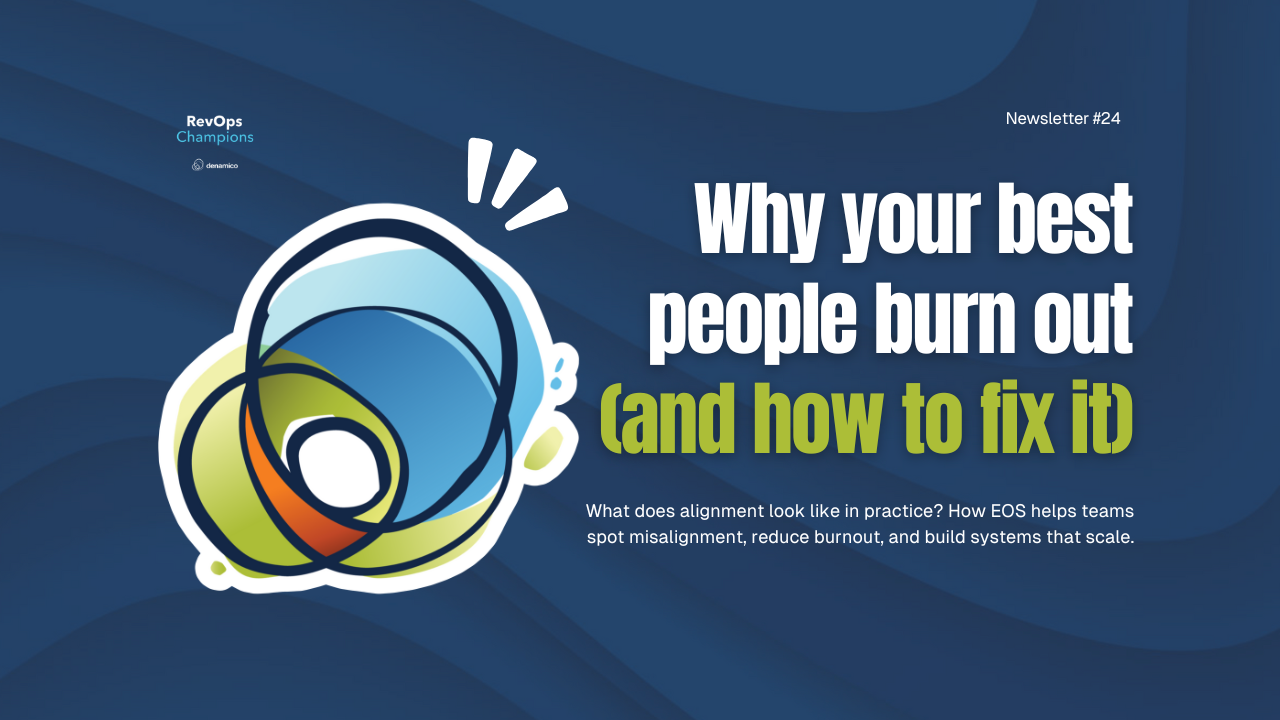RevOps Champions Newsletter #24
Alignment.
We use this word a lot in business today. Like Culture. Like Strategy. Everyone agrees it’s important—but what does it really mean?
Have you ever sat in a meeting where everyone agreed on the goal, but each person was planning to march in a different direction to get there?
What does alignment actually look like in practice?
👍🏼 Is it Sales selling services that make it easy for the Delivery team to succeed in creating happy clients?
👍🏼 Is the Operations team fully understanding what the client bought—and delivering on it with excellence?
👍🏼 Is it having systems connected, so every team can easily access the data they need for daily decisions?
👍🏼 Is it a leadership team with different responsibilities and competing priorities making decisions in the order of Client → Company → Team → Individual?
👍🏼 Is it team leaders listening to their people and creating tools that make it easier for them to do great work?
If any of these made you wince because they’re not happening, you know what misalignment looks and feels like.
It might look something like this:
👎🏼 Sales sells whatever the client asks for—even if it sets up the delivery team to fail.
👎🏼 Ops has to dig through Slack threads and old emails just to figure out what the client actually bought.
👎🏼 Every team uses a different system and nobody can get a straight answer without asking three people.
👎🏼 Leadership says “client-first”...but decisions still come down to department goals or personal preferences.
👎🏼 Team leads are too busy reacting to requests to actually build tools that make the work easier.
This leads to:
- Slow handoffs
- Conflicting priorities
- Shadow systems
- Burned-out high performers
"I don't think people burn out from working hard. They burn out from working hard and not seeing any return from that. And any effort around alignment really helps to illustrate that."
- Sean Steigerwald, Founder & CEO of Customer IQ, on the RevOps Champions podcast
Sean’s words hit home for me.
Misalignment doesn’t just slow things down—it discourages people. It turns great effort into wasted motion. And left unchecked, it’s one of the fastest ways to burn out our best people.
At Denamico, we use the Entrepreneurial Operating System (EOS) to bring alignment from theory into daily practice. One of the reasons we love it? Its six key components give us a clear lens to diagnose problems and build stronger systems.
🔭 Vision
Everyone rowing in the same direction.
Does every team member—from Sales to Customer Success—understand where we’re going and how their role contributes? If our teams are executing without a shared vision, we’re chasing speed without direction.
🧑🤝🧑 People
Right people, right seats, shared priorities.
Do our team members make decisions in the order of Client → Company → Team → Individual? Alignment at the people level means shared values, clear roles, and consistent prioritization, especially when things get busy.
📊 Data
A common language for truth.
Are we measuring what matters—and doing it consistently across departments? When teams align around a few key numbers (the fewer the better), decision-making becomes faster, cleaner, and less emotional.
🧩 Issues
A healthy place to name and solve problems.
Is there a regular, structured way to say, “This isn’t working”? Alignment requires trust. A weekly habit of identifying and solving issues (the EOS IDS process), prevents problems from getting buried—or worse, becoming personal.
🔄 Process
Documented. Followed by all.
Do we have a consistent, repeatable way to hand off clients between Sales, Delivery, and Success? Alignment means expectations are clear so we have smoother transitions, because everyone is using the same playbook.
📅 Traction
Execution with discipline.
Are we doing what we said we’d do—every week, every quarter? Alignment isn’t a kickoff conversation. It’s a weekly scorecard, clear ownership, and accountability at every level of the organization.
So what can we do with this?
If alignment feels fuzzy, EOS gives us a framework to make it concrete.
It’s not just about feel-good teamwork. It’s about building a system where:
- People know what’s expected.
- Roles connect to purpose.
- Decisions are grounded in truth.
And when misalignment shows up—and it will—you don’t have to guess.
You check your Vision, People, Data, Issues, Process, and Traction.
At Denamico, we’re doing that right now.
We’ve grown a lot this year—and our Process component is feeling the strain. Some things that used to work… don’t. So we’re rebuilding.
And while that’s hard, it’s also motivating. It’s showing us where we need to evolve and giving us a chance to build better, for ourselves and for our clients.
So if something feels “off” in your business right now, ask yourself:
“Where might we be misaligned and what EOS component can help us realign?”
You might be surprised how clear the next step becomes.
Cheers to growing better, together. 🌱
Kristin
 |
Kristin Dennewill
|

